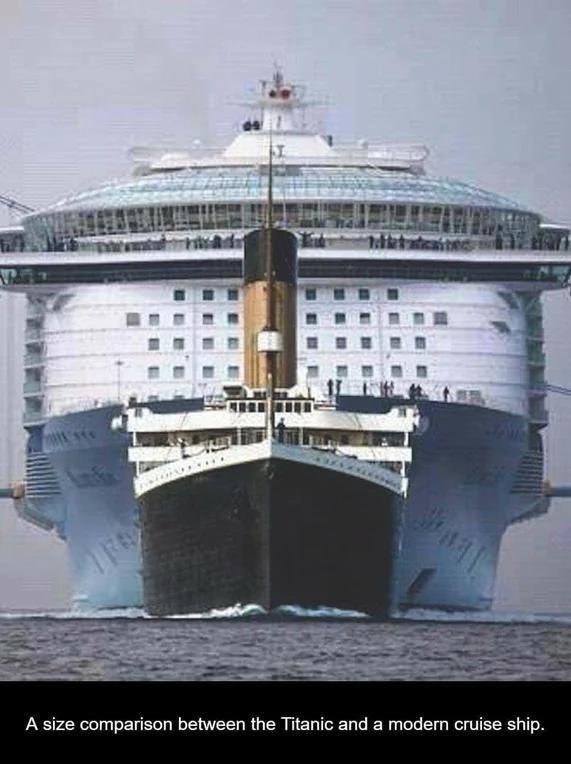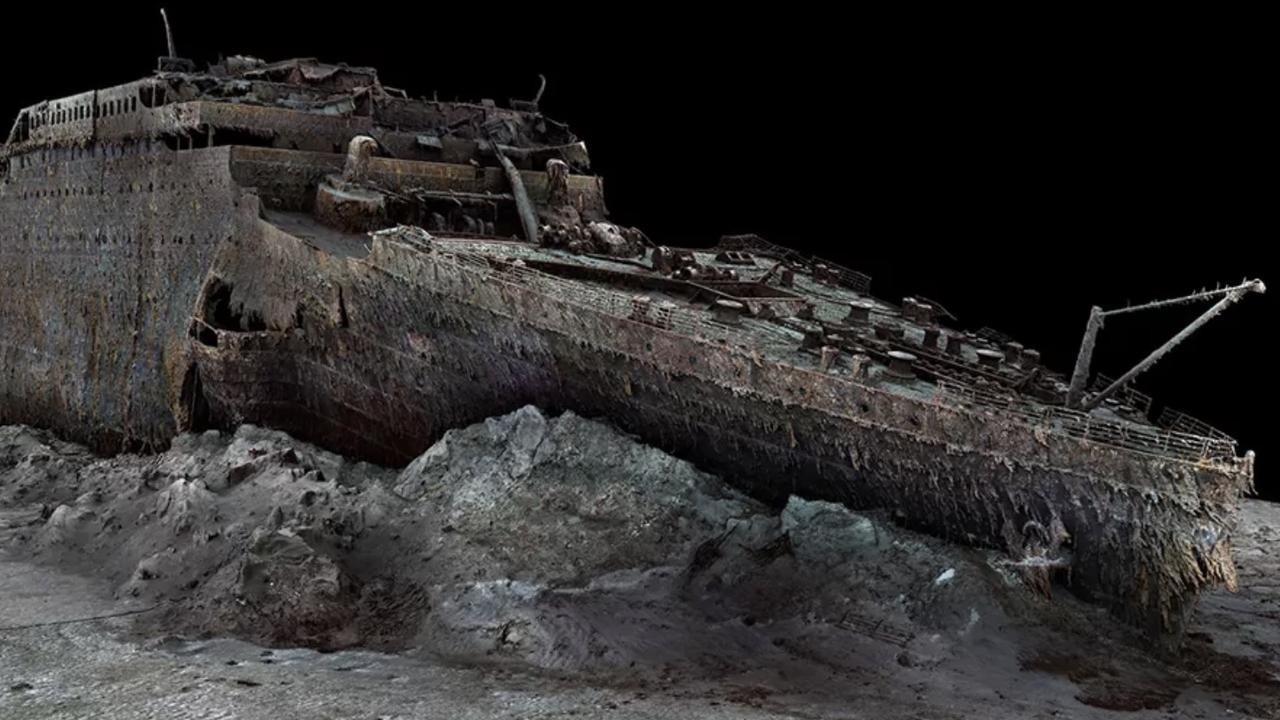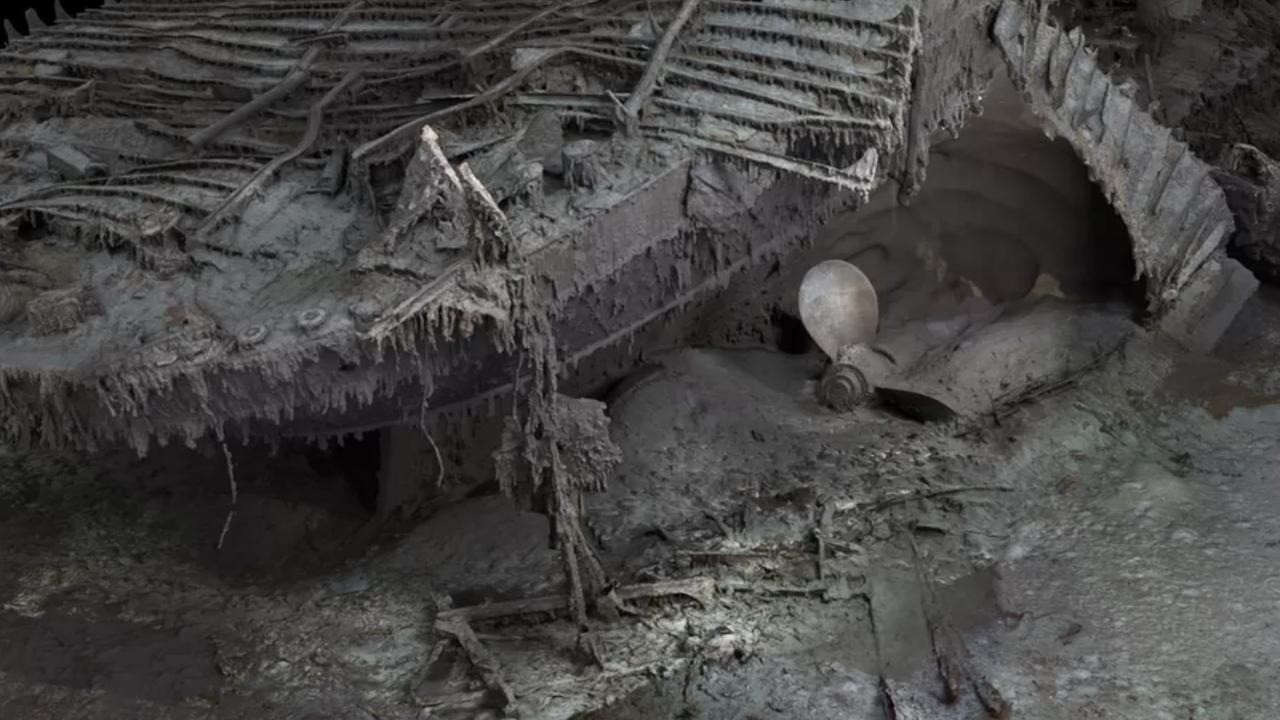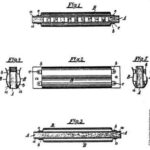The Titanic, a name synonymous with grandeur and tragedy, was once the largest passenger liner. However, when juxtaposed with today’s behemoth cruise ships, the size difference is staggering, prompting many to compare these vessels. COMPARE.EDU.VN offers comprehensive comparisons to help you visualize the scale and understand the evolution of maritime engineering, providing clarity on this comparison and guiding you towards making informed decisions. Explore our platform for detailed analysis, scale comparisons, and expert insights, uncovering the secrets behind the size, safety, and technological advancements that set these ships apart using scale visualization, historical maritime, and ship comparison.
1. Understanding the Titanic’s Dimensions
The Titanic, launched in 1911 and sunk on its maiden voyage in 1912, held the title of the largest ship of its time. Understanding its dimensions provides a baseline for comparing it to modern cruise liners. While it was an engineering marvel for its era, modern ships have far surpassed it in size and capacity.
1.1 Key Measurements of the Titanic
To understand the magnitude of the Titanic, it’s important to look at its key measurements:
- Length: 882.5 feet (269 meters)
- Beam (Width): 92 feet (28 meters)
- Height: Approximately 10 stories high
- Gross Tonnage: 46,328 GT
These dimensions made the Titanic a symbol of luxury and technological advancement at the time. However, when compared to today’s cruise ships, these figures reveal how much maritime engineering has evolved.
1.2 Capacity and Decks
The Titanic was designed to accommodate a large number of passengers and crew. Its capacity and deck layout played a crucial role in its operations:
- Passenger Capacity: Approximately 2,435 passengers
- Crew: Around 892 crew members
- Number of Decks: 10 decks
These numbers reflect the standards of early 20th-century ocean travel. Modern cruise ships dwarf these figures, offering a more expansive and amenity-rich experience.
2. Modern Cruise Ships: Giants of the Sea
Modern cruise ships represent a significant leap in maritime technology and design. These floating resorts are not just modes of transportation; they are destinations in themselves, offering a wide array of amenities and experiences. Their massive size is one of the most striking differences when compared to the Titanic.
2.1 Examples of Large Modern Cruise Ships
Several modern cruise ships stand out for their impressive size:
- Royal Caribbean’s Icon of the Seas: Due to sail in 2024, it measures 1,197.5 feet long, with a 213-foot beam, and 20 decks high.
- Wonder of the Seas: Another Royal Caribbean ship, it measures 1,188 feet in length and has a gross tonnage of approximately 236,857 GT.
- Harmony of the Seas: Part of the same class as Wonder of the Seas, it is slightly shorter but still massive, with a length of 1,188 feet and a gross tonnage of around 226,963 GT.
These ships are not only larger than the Titanic but also offer a vastly different cruising experience.
2.2 Key Measurements of Modern Cruise Ships
To fully grasp the size difference, let’s compare the measurements:
| Feature | Titanic | Icon of the Seas | Wonder of the Seas |
|---|---|---|---|
| Length | 882.5 feet (269 m) | 1,197.5 feet (365 m) | 1,188 feet (362 m) |
| Beam (Width) | 92 feet (28 m) | 213 feet (65 m) | 215.5 feet (65.7 m) |
| Height | 10 Decks | 20 Decks | 18 Decks |
| Gross Tonnage | 46,328 GT | 250,800 GT | 236,857 GT |
| Pass Capacity | ~2,435 | ~7,600 | ~6,988 |
| Crew | ~892 | ~2,350 | ~2,300 |



This table clearly illustrates the significant increase in size and capacity from the Titanic to modern cruise ships. The Icon of the Seas, for example, is over 300 feet longer and has more than double the number of decks.
2.3 Passenger and Crew Capacity
The capacity of modern cruise ships has also grown exponentially:
- Icon of the Seas: Can accommodate around 7,600 passengers and 2,350 crew members.
- Wonder of the Seas: Has a capacity of approximately 6,988 passengers and 2,300 crew members.
- Harmony of the Seas: Can carry around 6,780 passengers and 2,100 crew members.
These numbers highlight the scale of operations on modern cruise ships, which are designed to cater to a large and diverse group of people.
3. A Visual Comparison: Titanic vs. Modern Cruise Ships
Comparing the Titanic to modern cruise ships visually helps to emphasize the differences in size and scale. Imagine the Titanic next to one of today’s mega-ships; the contrast is striking.
3.1 Scale Comparisons in Length, Width, and Height
Visually, the Titanic would appear significantly smaller in all dimensions when placed next to a modern cruise ship. The added length, width, and height of modern ships contribute to their enormous gross tonnage and passenger capacity. This visual comparison underscores the advancements in naval architecture and engineering over the past century.
3.2 Deck Layout and Amenities
The deck layout and amenities available on modern cruise ships are vastly different from those on the Titanic. Modern ships boast multiple swimming pools, water parks, shopping malls, theaters, casinos, and a wide variety of dining options. The Titanic, while luxurious for its time, offered a more limited range of amenities, primarily focused on dining, socializing, and relaxation.
3.3 Image Overlays and Graphics
Using image overlays and graphics can provide a clear and compelling comparison of the Titanic and modern cruise ships. These visuals help to illustrate the scale difference and provide context for understanding the evolution of cruise ship design. Such graphics often show the Titanic superimposed onto a modern ship, allowing viewers to appreciate the size disparity at a glance.
4. Technological Advancements and Design Innovations
The differences in size between the Titanic and modern cruise ships are not merely cosmetic. They reflect significant advancements in technology, design, and safety features. These innovations have transformed the cruise industry, making modern voyages safer, more comfortable, and more entertaining.
4.1 Engineering and Construction Techniques
The engineering and construction techniques used to build the Titanic were state-of-the-art for the early 20th century, but they pale in comparison to modern methods. Today’s ships are constructed using advanced materials, computer-aided design (CAD), and modular construction techniques. These innovations allow for the creation of larger, more complex, and more efficient vessels.
4.2 Safety Features and Regulations
Safety features and regulations have evolved significantly since the Titanic era. Modern cruise ships are equipped with advanced navigation systems, fire suppression systems, lifeboats for every passenger and crew member, and stringent safety protocols. International regulations, such as the Safety of Life at Sea (SOLAS) convention, ensure that ships meet rigorous safety standards. The Titanic, by contrast, had insufficient lifeboats for all passengers and crew, a factor that contributed to the high death toll.
4.3 Navigation and Propulsion Systems
Modern cruise ships utilize sophisticated navigation and propulsion systems. GPS, radar, and electronic charting systems provide precise navigation, while advanced propulsion systems, such as azipods, offer greater maneuverability and fuel efficiency. The Titanic relied on traditional navigation methods and steam-powered engines, which were less efficient and less precise than today’s technologies.
5. The Cruising Experience: Then and Now
The cruising experience has undergone a dramatic transformation since the days of the Titanic. What was once a mode of transportation for the wealthy has become a mainstream vacation option, offering a wide range of destinations, activities, and amenities.
5.1 Onboard Amenities and Entertainment
The onboard amenities and entertainment options available on modern cruise ships are unparalleled. Passengers can enjoy multiple swimming pools, water parks, rock climbing walls, ice skating rinks, casinos, theaters, and a variety of dining options, from casual buffets to gourmet restaurants. The Titanic, while luxurious for its time, offered a more limited range of amenities, primarily focused on dining, socializing, and relaxation.
5.2 Destination Variety and Itineraries
Modern cruise ships offer a vast array of destinations and itineraries. Passengers can choose from cruises to the Caribbean, Alaska, Europe, Asia, and many other regions around the world. Itineraries range from short weekend getaways to multi-week voyages, catering to a wide variety of interests and budgets. The Titanic, on its maiden voyage, was destined for New York City, representing a more limited scope of travel.
5.3 Cost and Accessibility
Cruising has become more accessible to a broader range of travelers due to increased competition and a wider variety of cruise options. While luxury cruises can still be expensive, many affordable options are available, making cruising a popular vacation choice for families, couples, and solo travelers. The Titanic, by contrast, was primarily accessible to the wealthy elite, with ticket prices reflecting the exclusivity of the experience.
6. The Legacy of the Titanic and Its Impact on Cruise Travel
The Titanic’s legacy continues to resonate in the cruise industry today. The tragedy of its sinking led to significant improvements in safety regulations and practices, shaping the way modern cruise ships are designed and operated.
6.1 Changes in Safety Regulations
The sinking of the Titanic prompted major changes in safety regulations, including the implementation of the International Convention for the Safety of Life at Sea (SOLAS). These regulations mandate that ships carry sufficient lifeboats for all passengers and crew, conduct regular safety drills, and adhere to strict construction and operational standards. Modern cruise ships are designed with multiple layers of safety features, reflecting the lessons learned from the Titanic disaster.
6.2 Memorials and Museums
Numerous memorials and museums around the world commemorate the Titanic and its passengers. These sites serve as a reminder of the human cost of the tragedy and honor the lives lost. They also provide educational opportunities for visitors to learn about the ship, its history, and its impact on maritime travel.
6.3 The Enduring Fascination with the Titanic
The Titanic continues to capture the imagination of people around the world. Its story has been told in countless books, films, and documentaries, keeping its memory alive for generations. The enduring fascination with the Titanic reflects its significance as a symbol of human ambition, technological hubris, and the tragic consequences of unforeseen events.
7. Examining Gross Tonnage: A Key Metric
Gross tonnage (GT) is a crucial metric for understanding the size and capacity of a ship. It is a measure of the total internal volume of a ship, with one gross ton equivalent to 100 cubic feet. Comparing the GT of the Titanic to modern cruise ships provides a clear indication of the scale difference.
7.1 What Gross Tonnage Represents
Gross tonnage is not a measure of weight but rather of volume. It includes all enclosed spaces on a ship, from passenger cabins to cargo holds to engine rooms. A higher GT indicates a larger ship with more space for passengers, crew, and amenities.
7.2 Comparing GT: Titanic vs. Modern Ships
The Titanic had a gross tonnage of 46,328 GT, which was considerable for its time. However, modern cruise ships far exceed this figure. The Icon of the Seas, for example, has a gross tonnage of approximately 250,800 GT, while the Wonder of the Seas has a GT of around 236,857 GT. This difference in GT underscores the significant increase in size and capacity from the Titanic to modern cruise ships.
7.3 The Significance of GT in Cruise Ship Design
Gross tonnage plays a significant role in cruise ship design and operation. It influences the number of passengers and crew that can be accommodated, the amount of cargo that can be carried, and the types of amenities that can be offered. A higher GT allows for more diverse and expansive onboard experiences, contributing to the appeal of modern cruise vacations.
8. Passenger Experience: Comfort and Luxury
The passenger experience on modern cruise ships is vastly different from that on the Titanic. Today’s ships offer a level of comfort and luxury that was unimaginable in the early 20th century.
8.1 Cabin Sizes and Amenities
Cabin sizes on modern cruise ships are generally larger and more comfortable than those on the Titanic. Modern cabins often include private balconies, en-suite bathrooms, flat-screen TVs, and other amenities designed to enhance the passenger experience. The Titanic offered a range of cabin classes, with first-class cabins being luxurious for their time but still smaller and less well-equipped than modern equivalents.
8.2 Dining Options and Culinary Experiences
Modern cruise ships offer a wide variety of dining options, from casual buffets to gourmet restaurants. Passengers can choose from a range of cuisines, including Italian, French, Asian, and American. Many ships also feature celebrity chef partnerships, offering exclusive culinary experiences. The Titanic offered a more limited range of dining options, with meals served in formal dining rooms and catering to the tastes of the wealthy elite.
8.3 Recreational Activities and Entertainment
Recreational activities and entertainment options on modern cruise ships are extensive. Passengers can enjoy swimming pools, water parks, rock climbing walls, ice skating rinks, casinos, theaters, and a variety of live music and shows. The Titanic offered a more limited range of recreational activities, primarily focused on socializing, reading, and playing games.
9. Environmental Considerations and Sustainability
Environmental considerations and sustainability are increasingly important in the cruise industry. Modern cruise ships are designed with features to reduce their environmental impact, such as energy-efficient engines, waste management systems, and water treatment technologies.
9.1 Modern Ship Technologies for Reducing Impact
Modern cruise ships utilize a variety of technologies to reduce their environmental impact. These include:
- Exhaust gas cleaning systems (scrubbers): Remove pollutants from exhaust gases.
- Wastewater treatment plants: Treat and purify wastewater before discharge.
- Energy-efficient lighting and appliances: Reduce energy consumption.
- Hull designs: Optimized to reduce drag and improve fuel efficiency.
9.2 Industry Efforts Towards Sustainability
The cruise industry is actively working to improve its sustainability practices. Cruise lines are investing in new technologies, implementing stricter environmental policies, and partnering with environmental organizations to reduce their carbon footprint and protect marine ecosystems.
9.3 Comparing the Environmental Footprint
Comparing the environmental footprint of the Titanic to modern cruise ships is challenging due to the differences in technology and regulations. However, modern ships are subject to stricter environmental standards and utilize more advanced technologies to minimize their impact. The Titanic, by contrast, operated in an era with less awareness of environmental issues and fewer regulations.
10. Addressing Common Questions: FAQs
Here are some frequently asked questions about the size comparison between the Titanic and modern cruise ships:
10.1. Was the Titanic really the largest ship of its time?
Yes, when it was launched in 1911, the Titanic was the largest passenger ship ever built. Its dimensions and gross tonnage exceeded those of any other ship at the time.
10.2. How much bigger are modern cruise ships compared to the Titanic?
Modern cruise ships are significantly larger than the Titanic. For example, the Icon of the Seas is over 300 feet longer and has more than five times the gross tonnage of the Titanic.
10.3. What is gross tonnage, and why is it important?
Gross tonnage is a measure of the total internal volume of a ship. It is an important metric for understanding the size and capacity of a vessel and influences the number of passengers and crew that can be accommodated.
10.4. Did the Titanic have enough lifeboats for everyone on board?
No, the Titanic did not have enough lifeboats for all passengers and crew. This was a major contributing factor to the high death toll when the ship sank.
10.5. How have safety regulations changed since the Titanic disaster?
The sinking of the Titanic led to significant improvements in safety regulations, including the implementation of the International Convention for the Safety of Life at Sea (SOLAS). These regulations mandate that ships carry sufficient lifeboats for all passengers and crew and adhere to strict construction and operational standards.
10.6. What kinds of amenities are available on modern cruise ships?
Modern cruise ships offer a wide range of amenities, including multiple swimming pools, water parks, casinos, theaters, gourmet restaurants, and a variety of recreational activities and entertainment options.
10.7. How has the cruising experience changed since the Titanic era?
The cruising experience has become more accessible, comfortable, and luxurious. Modern cruise ships offer a wider range of destinations, itineraries, and onboard amenities, catering to a diverse range of travelers.
10.8. Are modern cruise ships safer than the Titanic?
Yes, modern cruise ships are significantly safer than the Titanic. They are equipped with advanced navigation systems, fire suppression systems, and lifeboats for every passenger and crew member, and they adhere to strict safety regulations.
10.9. How do modern cruise ships address environmental concerns?
Modern cruise ships utilize a variety of technologies to reduce their environmental impact, such as exhaust gas cleaning systems, wastewater treatment plants, and energy-efficient lighting and appliances.
10.10. Where can I learn more about the Titanic?
There are numerous memorials and museums around the world dedicated to the Titanic. Additionally, many books, films, and documentaries have been produced about the ship and its history.
Conclusion: The Evolution of Maritime Giants
The comparison between the Titanic and modern cruise ships highlights the remarkable evolution of maritime engineering and the cruise industry. While the Titanic was a marvel of its time, modern ships have surpassed it in size, safety, and amenities. This evolution reflects advancements in technology, design, and a commitment to providing passengers with a more comfortable, entertaining, and safe cruising experience.
Ready to explore more comparisons and make informed decisions? Visit COMPARE.EDU.VN today to discover a wealth of information and insights. Our comprehensive comparisons cover a wide range of topics, helping you navigate the complexities of choice with confidence. Contact us at 333 Comparison Plaza, Choice City, CA 90210, United States or via Whatsapp at +1 (626) 555-9090. Your informed decision starts here at compare.edu.vn.
